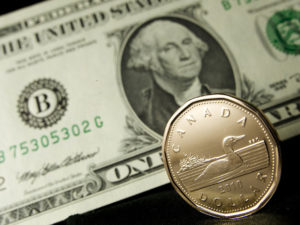 US dollar rose to highs unseen in five months against its Canadian counterpart on Wednesday, as the number of initial jobless claims in the United States fell last week and overall durable goods orders decreased in October, while prices of crude oil, Canadas largest export, declined for a fourth day in a row, additionally pressuring demand for the loonie.
US dollar rose to highs unseen in five months against its Canadian counterpart on Wednesday, as the number of initial jobless claims in the United States fell last week and overall durable goods orders decreased in October, while prices of crude oil, Canadas largest export, declined for a fourth day in a row, additionally pressuring demand for the loonie.
USD/CAD touched a session high at 1.0593 at 14:30 GMT, also the pairs highest point since July 5th, after which consolidation followed at 1.0588, gaining 0.45% for the day. Support was likely to be received at November 25th low, 1.0526, while resistance was to be encountered at July 5th high, 1.0609.
According to the weekly report by the Department of Labor, the number of people, who filed for unemployment assistance in the United States, decreased for a sixth consecutive week in the past seven weeks, implying that labor market in the country continued to demonstrate resiliency. The number of initial jobless claims, an indicator for lay-offs in companies, dropped by 10 000 to reach 316 000 during the week ending on November 23rd 2013, confounding preliminary estimates pointing that claims will climb to 330 000. The number of claims in the preceding week has been revised up to 326 000 from 323 000 previously. The average number of claims during the past four weeks, an indicator considered as lacking seasonal effects, fell to 331 750.
This indicator tend to fluctuate during November and December because of the holiday season, as this usually requires significant seasonal corrections. If business entities in the country continue hiring at a stable pace, the Federal Reserve Bank may be prompted to reduce the scale of its monthly asset purchases from the current pace of 85 billion USD. Central banks next meeting on policy is scheduled on December 17th-18th.
In addition, demand for US durable goods orders weakened in October due to the considerable decline in business investments, while this may cause a negative impact on nations economic growth during the final quarter of the year. Durable goods orders fell 2.0% in October compared to a month ago, following two consecutive monthly gains. Orders climbed at the revised up rate of 4.1% in September. Durable goods orders, which exclude the volatile sector of transportation, dipped 0.1% in October, marking a third monthly drop in a row during the past four months. Durable goods orders, excluding another volatile category, defense, fell 1.3% in October, after rising 3.4% in September. Experts had anticipated that overall durable goods orders will decrease 1.9% last month.
The above mentioned results reflect the reduced investment activity of companies due to 16 days of partial government shutdown in October. Also, demand for durable goods decreased on a broad scale, including sectors such as aviation, computer technologies, metallurgy.
Meanwhile, the loonie, as Canadian dollar is also nicknamed, retreated against the greenback, as prices of crude oil plunged for a fourth day in a row. Crude oil futures with delivery in January were trading at $92.36 per barrel at 14:49 GMT, submerging 1.41% on a daily basis. The commodity has fluctuated as Iran and major world powers plan to strike an interim deal in order to set limits on nations nuclear program.
“We’ve seen some of the commodity currencies come a bit under pressure,” Sebastien Galy, a senior foreign-exchange strategist at Societe Generale SA in New York, said in a telephone interview, cited by Bloomberg News. “Some of the energy has essentially suffered a little bit. Indeed, what you’re seeing this morning is oil is falling.”
The yield on Canadian benchmark 10-year government bonds was little changed at 2.53%.
Elsewhere, the Canadian currency was losing ground against the euro, with EUR/CAD cross up 0.59% for the day to trade at 1.4396 at 14:55 GMT. GBP/CAD pair soared 0.97% to trade at 1.7264 at 14:55 GMT. The Canadian dollar has depreciated 3.3% this year against nine developed-nation currencies, which are tracked by the Bloomberg Correlation-Weighted Index. The US dollar has gained 3.7% during the same period.





